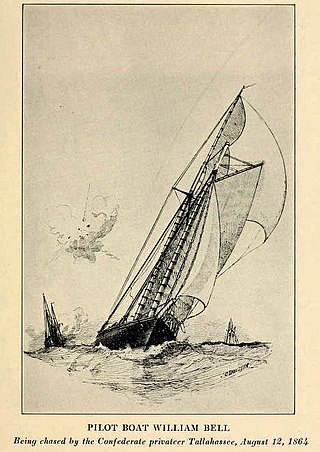
The William Bell was a pilot boat built in 1864 by shipbuilder Edward F. Williams at Greenpoint, Brooklyn for a group Sandy Hook Pilots. She was captured and burned by the Confederate raiding steamer CSS Tallahassee during the American Civil War. A second William Bell was constructed in 1864-1865 to replace the first one.
Isaac Webb, was a 19th-century shipbuilder, owner and founder of the Isaac Webb & Co. shipyard. He was one of the founders of shipbuilding in the United States.

C. & R. Poillon was a 19th-century shipyard company in Brooklyn, New York. The company employed over 300 workers, owned several shipyards, and launched 175 vessels. The company was one of the best known clipper ship firms and the last of the wooden hulled boat builders in New York.
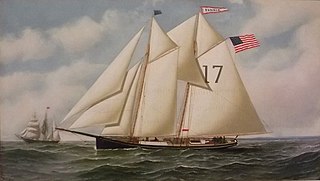
The Fannie was a 19th-century Sandy Hook pilot boat built in 1860 by Edward F. Williams at his shipyard in Greenpoint, Brooklyn for New York City pilots. She was in the pilot service during the American Civil War. In an age of steam, she was sold in 1896.
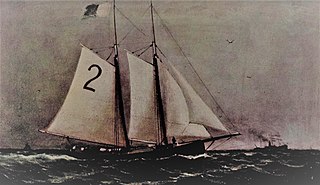
The Eben D. Jordan was a 19th-century Boston pilot boat built in 1883 by Ambrose A. Martin in East Boston for Captain Thomas Cooper. Her namesake was Eben Dyer Jordan, the founder of the Jordan Marsh department stores. In 1892, she was sold to the New York Sandy Hook pilots. She was one of the last of the pilot-boats that were discarded in an age of steam and electricity in 1896.

The Widgeon was a 19th-century yacht and Sandy Hook pilot boat, built in 1855 by James R. & George Steers for Daniel Edgar of the New York Yacht Club and designed by George Steers. She came in 17th in an unsuccessful America’s Cup defense in 1870. Widgeon was sold in 1871 to a group of New York pilots to replace the John D. Jones, which sank in a collision with the steamer City of Washington. New York pilots condemned the Widgeon as unseaworthy in 1879, which sparked a fight for steam pilot-boat service. In 1883 a decision was affirmed by the Supreme Court and the Board of Commissioners of Pilots that pilot boats could be "propelled" by steam.

The Charles H. Marshall was a 19th-century Sandy Hook pilot boat built by Henry Steers in 1860 for a group of New York pilots. She was in the Great Blizzard of 1888, the same year the National Geographic came out with an article about the successful struggle made by the crew of the Marshall. The boat was named in honor of the American businessman Charles Henry Marshall. In the age of steam she was sold in 1896.

The Mary A. Williams was a 19th-century Sandy Hook pilot boat, built in 1861 by the shipbuilder Edward F. Williams in Greenpoint, Brooklyn, for a group of New York pilots. She was named Mary Ann Williams after the wife of the builder. The boat was considered one of the finest connected with the pilot service. She survived the Great Blizzard of 1888. In the age of steam, the Mary A. Williams was sold in 1896.

The Jesse Carll was a 19th-century pilot boat, built in 1885 by Jesse Carll at Northport, New York, for George H. Sisco. She was one of the largest vessels ever built in the Sandy Hook service. She was named in honor of Jesse Carll, a well-known Northport shipbuilder. In 1896, in the age of steam, the Ezra Nye, along with other pilot boats, were replaced with steamboats.
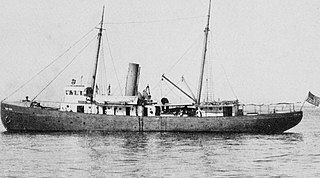
The New York was the first steam pilot boat in the New York harbor. She was built in 1897, by the Harlan and Hollingsworth company at Wilmington, Delaware for the a group of New York Sandy Hook pilots. She was designed by Archibald Cary Smith, who was a prominent naval architect and marine engineer. The New York was retired from pilot service in 1951.

The New Jersey was a steam pilot boat built by A. C. Brown & Sons of Tottenville, Staten Island in 1902 for the New York and New Jersey Sandy Hook Pilots' Association. After twelve years of service, the steamship SS Manchioneal rammed and sank her off Ambrose Lightship in 1914. The New Jersey was replaced by the pilot boat Sandy Hook.

The Jacob Bell was a 19th century Sandy Hook pilot boat built by the shipbuilder Jacob Bell for a group of New York Pilots in 1840. She was named in honor of the shipbuilder Jacob Bell, who was a partner in the Brown & Bell firm. After fourteen years of service she went ashore in a gale off Sandy Hook in 1854.
The James Avery was a 19th century Sandy Hook pilot boat built in 1837 for a group of New York Pilots. She was built by the shipbuilder Jacob Bell. The James Avery was a pilot boat during the American Civil War that helped in the search of the Confederate CSS Tallahassee. She was last seen in 1872, off the Highlands.

The David Carll was a 19th-century pilot boat, built in 1885 at the David Carll shipyard in City Island, New York. She was named in honor of David Carll, a well-known City Island shipbuilder. The David Carll was considered to be among the fastest schooners in the fleet. She was built to replace the Mary E. Fish that was run down and sank by the schooner Frank Harrington in 1885. She was one of the pilot boats that survived the Great Blizzard of 1888. The David Carll was lost at sea in 1893.
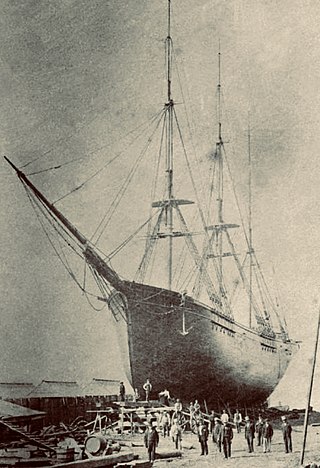
Edward Francis Williams, was a 19th-century shipbuilder. He apprenticed under his father Jabez Williams. Edward F. Williams built his own shipyard, building clipper ships and eleven Sandy Hook pilot boats, some of the finest boats in the fleet. He was the first president of the Greenpoint Savings Bank. Williams died in New Providence, New Jersey, in 1902.

The Joseph N. Lord was a 19th-century Sandy Hook pilot boat built in 1840 at the Jabez Williams shipyard in East River, for New York pilots. She helped transport maritime pilots between inbound or outbound ships coming into the New York Harbor. The Joseph N. Lord was lost at sea in 1845 at Port-au-Platt, Dominican Republic.

Ariel Patterson, was a 19th-century American shipbuilder. He apprenticed under shipbuilder Perrine, Patterson, and Stack in Williamsburg, Brooklyn. Patterson had his own shipyard, building and designing for 40 years some of the finest steamships. The most notable were the steamer Ericsson, which had the first Hot air engine invented by John Ericsson and the three-masted side-wheel SS Yankee Blade, one of the first steamships to trade between to New York and San Francisco. In 1863, Patterson bought property at the foot of North Third Street, where he started a shipbuilding, dockage and a sawing and planing mill. He died in Brooklyn, New York in 1877.

The George H. Warren was a 19th-century pilot boat built in 1882 by Porter Keene at Weymouth, Massachusetts, to replace the Edwin Forrest, No. 4, which was sold to the Pensacola, Florida pilots. The George H. Warren, originally belonged to the Boston pilot fleet but in 1889, she was purchase by a group of New York pilots. She and her crew were lost in the great blizzard of 1895.

Thomas D. Harrison was a 19th-century New York pilot boat built for New Jersey pilots. She was launched from the Jacob S. Ellis & Son shipyard, at Tottenville, Staten Island in 1875. The Harrison went ashore in the Great Blizzard of 1888 with no lives lost. She continued as a pilot boat with Pilot Stephen Cooper in command. She was purchased in 1897 by Allerton D. Hitch and used for coastal trade in the Cape Verde islands off the west African coast.

















